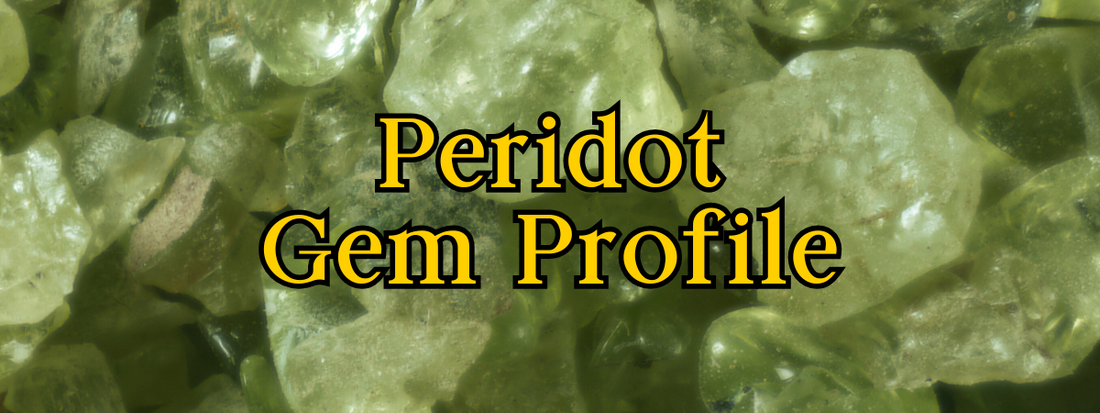
A Jeweller’s Guide to Peridot: Identification Tips and Jewellery Making Advice
Welcome to the vibrant world of peridot, a gemstone that practically glows with its cheerful green hues. As one of the few gemstones found in a single colour, peridot is instantly recognisable and undeniably unique.
From its ancient associations with the sun to its modern popularity in bold, contemporary designs, this gem has something for everyone. Whether you’re creating a minimalist pendant or a dazzling statement ring, peridot is sure to steal the spotlight. Ready to learn more about this sunny green gem? Let’s dive in!
 Basic Identification Information
Basic Identification Information
Name & Synonyms:
Peridot; also known as "evening emerald" or "chrysolite" in older texts.
Species:
Olivine
Colour Range:
Yellowish-green to green, with the most desirable tones being a vivid lime green.
Refractive Index:
1.654–1.690
Birefringence:
0.035–0.038
(This range is high enough that looking into a peridot (usually with a loupe) can result in you seeing double. i.e. you might see 2 lines where the facets meet instead of one)
Optical Sign:
Either Biaxial+ or Biaxial-
Specific Gravity:
3.34
Fluorescence:
None
Lustre:
Vitreous (bright and glass-like when polished).
Clarity:
Type 2
Can be eye clean, but usually included. Look out for "lily pad" inclusions, which are caused by crystal stress, as these are unique to peridot.
Gems often mistaken for peridot:
Green tourmaline, green sapphire, or demantoid garnet.
Mohs Hardness:
6.5–7
Wearability:
Good, but prone to scratches and fractures under impact.
Birthstone:
August
 Common Treatments
Common Treatments
Peridot is usually untreated, which is a rarity in the gem world! Its vivid colour is entirely natural, although synthetic peridot does exist, it is very rare to see it within the jewellery market.
Durability Considerations
While peridot scores a respectable 6.5–7 on the Mohs scale, it’s a bit softer and more brittle than some other jewellery favourites. Its tendency to fracture under pressure makes it a gemstone that requires a little extra TLC.
Peridot is also sensitive to heat and acids, so it’s not ideal for high-heat processes or exposure to harsh chemicals.
 Jeweller's Setting Tips
Jeweller's Setting Tips
Because peridot can be prone to scratching and chipping, protective settings like bezels or recessed designs are a jeweller’s best friend. Avoid using it in tension settings or designs where the stone is exposed to potential impact.
When setting, be mindful of its cleavage planes and work gently to avoid damage.
When doing a repair, be sure to unset your peridot before soldering to prevent accidental heat damage.
 Care Instructions
Care Instructions
Peridot is relatively easy to care for as long as you avoid ultrasonic or steam cleaners, which can be too harsh.
Stick to warm, soapy water and a soft brush for cleaning, and store peridot jewellery separately from harder gems, including quartz, to prevent scratches.
It’s also a good idea to remove peridot rings when being active, e.g. gardening or a gym sessions, to help prevent accidental knocks.
 Aesthetic & Design Insights
Aesthetic & Design Insights
Peridot’s vibrant green hues pair wonderfully with a variety of metals. Yellow gold enhances its warm undertones for a luxurious look, while white metals like silver or platinum bring out its crisp, refreshing green.
For an extra pop, pair peridot with complementary gemstones like diamonds, amethyst, or blue topaz.
Its glowing colour makes it ideal for summer-inspired pieces or nature-themed designs, and it shines especially bright in pendants and earrings.
 Market & Ethical Notes
Market & Ethical Notes
Most peridot comes from volcanic deposits, with major sources including Arizona (USA), China, Myanmar, and Pakistan. Stones from Pakistan’s Kashmir region, known for their rich lime-green hues, are especially prized.
Peridot is generally affordable, but larger, high-quality stones can command higher prices. The gem is often mined in areas where ethical sourcing is a challenge, so it’s important to work with suppliers who provide transparency and support sustainable practices.
 Symbolic & Spiritual Meanings
Symbolic & Spiritual Meanings
Known as the "gem of the sun," peridot is said to radiate positivity and protect against negative vibes. Ancient Egyptians believed it could ward off nightmares and evil spirits, while modern enthusiasts consider it a stone of abundance and renewal. Whether or not it’s true, its cheerful green glow is guaranteed to brighten anyone’s day.
 Etymology
Etymology
The name peridot has an intriguing and debated origin.
Many scholars believe it comes from the Arabic word "faridat", meaning "gem" or "precious stone." This theory aligns with the historical mining of peridot on St. John's Island (Zabargad) in the Red Sea, where Arabic-speaking traders were active.
Another theory suggests an Old French origin, deriving from "peritot," meaning "unclear" or "unspecified." This could refer to peridot’s soft, misty green hue.
The name peridot has been used in English since at least the 18th century to distinguish it from other green gemstones like emerald.
